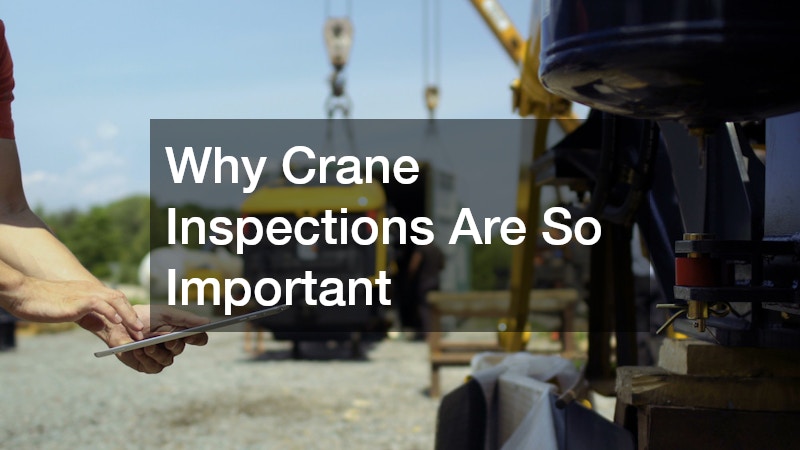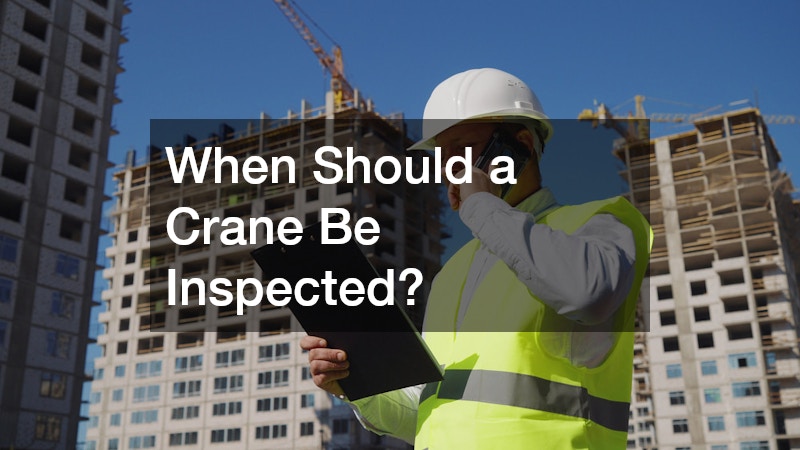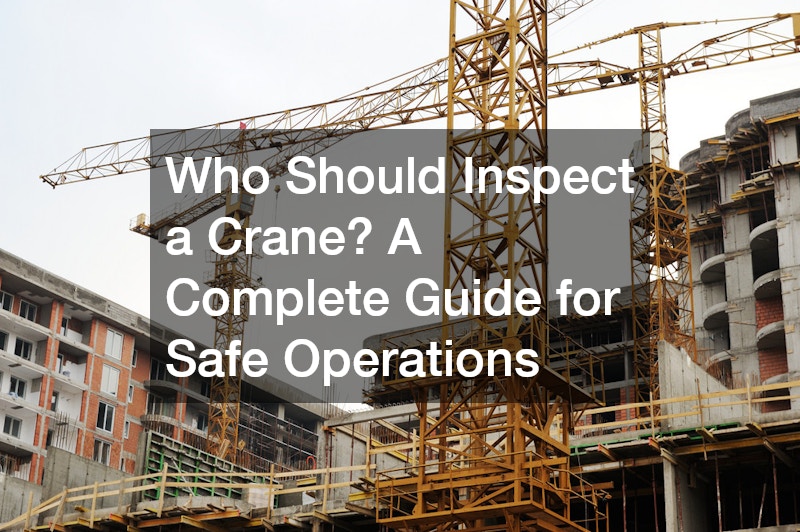Cranes are powerful machines that make lifting heavy loads possible on construction sites, in factories, and at shipping yards. But because cranes handle such dangerous tasks, they must be inspected regularly to make sure they’re safe to operate.
One of the most common questions from business owners, safety managers, and equipment operators is: “Who should inspect a crane?” The answer matters because using an unqualified inspector can lead to accidents, expensive repairs, and even legal trouble.
In this guide, we’ll explain exactly who is qualified to inspect a crane, what kinds of inspections are required, and why proper inspections are vital for workplace safety.
Why Crane Inspections Are So Important

Crane inspections aren’t just a formality—they are required by law in many situations. These inspections catch problems like worn-out cables, hydraulic leaks, or electrical issues before they cause accidents.
A poorly maintained crane can:
- Drop heavy loads, causing injuries or fatalities
- Damage property and equipment
- Delay projects and increase costs
- Lead to OSHA fines or legal liability
Regular inspections reduce these risks, improve efficiency, and protect both workers and equipment.
Who Is Qualified to Inspect a Crane?
According to OSHA (Occupational Safety and Health Administration) and ASME (American Society of Mechanical Engineers) standards, a crane must be inspected by a “qualified person.”
A qualified person is someone who:
- Has specific knowledge and training in crane operation and maintenance
- Understands applicable safety standards and manufacturer guidelines
- Can recognize hazards and know how to correct them
- Has practical experience with crane inspection procedures
This means not just anyone can inspect a crane—not even a skilled operator—unless they’ve had proper inspection training.
Types of Qualified Inspectors
There are different types of professionals who may be qualified to inspect a crane depending on the type of inspection needed:
- Certified Crane Inspectors
- These are professionals who have passed a recognized certification program, such as those offered by the Crane Institute Certification (CIC) or the National Commission for the Certification of Crane Operators (NCCCO).
- They are trained to perform thorough examinations and document findings for compliance purposes.
- Manufacturer-Authorized Technicians
- These technicians work directly for, or are trained by, the crane’s manufacturer.
- They have in-depth knowledge of the specific crane model’s parts, functions, and known problem areas.
- Third-Party Inspection Services
- Independent companies specializing in crane inspections.
- They often bring an unbiased perspective and ensure compliance with OSHA, ASME, and insurance requirements.
- In-House Qualified Inspectors
- Some large companies employ their own inspectors who meet OSHA’s “qualified person” definition.
- These employees must still receive formal training and certification.
When Should a Crane Be Inspected?

Crane inspections aren’t just a one-time requirement. OSHA mandates different inspection schedules based on how often the crane is used and the potential for wear and tear.
Types of crane inspections include:
- Initial Inspection
- Done before the crane is used for the first time.
- Ensures proper assembly and functioning of all parts.
- Frequent Inspections
- Performed daily or weekly depending on usage.
- Usually handled by the operator or an on-site qualified person.
- Focuses on checking wire ropes, hooks, brakes, and safety devices.
- Periodic Inspections
- Conducted monthly, quarterly, or annually depending on crane usage.
- These are more thorough and often performed by certified inspectors.
- Involves checking structural components, load-handling parts, and electrical systems.
- Special Inspections
- Required after an accident, overload event, or major repair.
- Performed by a highly experienced, qualified inspector.
Key Responsibilities of a Crane Inspector
A qualified crane inspector’s job goes far beyond simply walking around the crane and giving it a quick glance. Their role is critical to ensuring safety, preventing costly breakdowns, and keeping operations compliant with OSHA regulations.
Some of their main duties include:
- Checking structural integrity: Inspectors carefully examine the crane’s booms, jibs, and frames for cracks, corrosion, bends, or other signs of structural weakness. Even small defects can grow into dangerous failures if left untreated.
- Examining mechanical parts: They assess gears, bearings, brakes, hydraulic systems, and other moving components to ensure they operate smoothly and efficiently. Any worn or damaged part could lead to mechanical failure.
- Testing safety devices: Safety systems such as limit switches, overload protection devices, and emergency stop buttons are tested to confirm they work properly. These safeguards are essential for preventing accidents.
- Assessing wire ropes and chains: The inspector checks for frayed wires, broken strands, kinks, or excessive wear that could compromise lifting capacity and safety.
- Reviewing records: Maintenance logs, inspection reports, and repair histories are reviewed to ensure the crane’s upkeep meets industry standards and legal requirements.
After the inspection, the inspector prepares a detailed report highlighting any problems found, recommended repairs, and whether the crane is safe to operate. This documentation is important for compliance, liability protection, and planning future maintenance.
OSHA and ASME Standards for Crane Inspections
OSHA and ASME provide strict guidelines for crane inspections to ensure safety.
- OSHA Standard 29 CFR 1910.179 covers overhead and gantry cranes, while 29 CFR 1926 Subpart CC covers cranes in construction.
- ASME B30 Standards detail inspection procedures, maintenance requirements, and qualifications for inspectors.
Compliance with these standards is not optional—failure to follow them can result in heavy fines and legal consequences.
Why Using a Certified Inspector Matters
Hiring a certified inspector is not just about checking a box—it’s about ensuring that the person evaluating your crane knows what to look for and how to spot hidden dangers.
Benefits of certified inspections include:
- Higher accuracy in spotting problems
- Reduced risk of mechanical failure
- Better documentation for insurance and OSHA audits
- Increased lifespan of crane equipment
A certified inspector can also recommend preventative maintenance that saves you money in the long run.
Common Problems Found During Inspections
Even experienced crane operators can overlook issues that a trained inspector is specifically trained to detect. During a thorough inspection, it’s common to uncover:
- Cracks in welds or metal components: These small fractures can grow over time, weakening the crane’s structure and increasing the risk of collapse under heavy loads.
- Damaged wire ropes or chains: Frays, kinks, broken strands, or stretched links can severely reduce lifting capacity and create a serious safety hazard.
- Worn-out brakes or clutch mechanisms: If braking systems or clutches fail, it can lead to uncontrolled movement, load drops, or operational delays.
- Corroded electrical connections: Rust, oxidation, or moisture damage can interfere with the crane’s control systems, causing erratic or unsafe operation.
- Malfunctioning safety devices: Limit switches, overload protection systems, and emergency stop controls that don’t work properly can fail to prevent accidents when needed most.
Catching these problems early allows for timely repairs, reducing the risk of costly downtime, equipment damage, and workplace injuries. Preventive maintenance based on inspection results is one of the most effective ways to extend a crane’s lifespan and ensure safe operation.
How to Choose the Right Crane Inspector
Selecting a qualified crane inspector isn’t just a formality—it’s a critical decision that directly impacts workplace safety, operational efficiency, and regulatory compliance. Not all inspectors bring the same level of expertise, so it’s important to vet candidates carefully. Before hiring, consider asking:
- Do they have OSHA-recognized certification? Certification from OSHA or another recognised authority ensures the inspector meets industry standards and understands current safety regulations.
- Are they familiar with your crane’s make and model? Different crane types—tower, mobile, overhead—have unique components and inspection requirements. An inspector experienced with your specific model will be more efficient and thorough.
- Can they provide references from past clients? Speaking with previous clients can reveal how reliable, detail-oriented, and professional the inspector is in real-world situations.
- Do they carry liability insurance? Insurance coverage protects your business from potential disputes or damages related to the inspection process.
- How detailed is their inspection process and report? A professional should provide a clear outline of what they check, use precise measurements where applicable, and deliver a comprehensive written report with photos, findings, and recommendations.
Choosing the right inspector is an investment in preventing costly breakdowns, avoiding legal issues, and ensuring your crane operates at peak safety and efficiency. The most competent inspectors don’t just check boxes—they identify potential risks before they become serious problems.
Costs of Crane Inspections
The cost of a crane inspection depends on factors such as the type of crane, its size, and the depth of inspection required.
- Frequent inspections: May cost less and be done in-house.
- Periodic or annual inspections: Often range from a few hundred to several thousand dollars.
While inspections can seem costly, they are far cheaper than the potential losses from an accident or equipment failure.
Legal and Insurance Considerations
Many insurance providers require proof of regular crane inspections to maintain coverage. If an accident occurs and the inspection records are missing or incomplete, your claim could be denied.
Additionally, OSHA can issue fines for failing to have cranes inspected by a qualified person. Keeping detailed inspection records protects you legally and financially.
Best Practices for Crane Inspection Compliance
To ensure your cranes are always safe and compliant:
- Keep an inspection schedule and stick to it.
- Use only qualified, certified inspectors for periodic inspections.
- Document every inspection and keep reports for at least three years.
- Train operators to perform daily checks and report issues immediately.
These practices not only keep you compliant but also protect your workers and equipment.
Final Thoughts
When it comes to crane inspections, the answer to “Who should inspect a crane?” is clear—only a qualified person with the right training, certification, and experience. This ensures that your crane is safe, compliant, and ready for the job.
By following OSHA and ASME guidelines, hiring certified professionals, and keeping up with regular inspections, you can avoid accidents, protect your investment, and maintain smooth operations.
